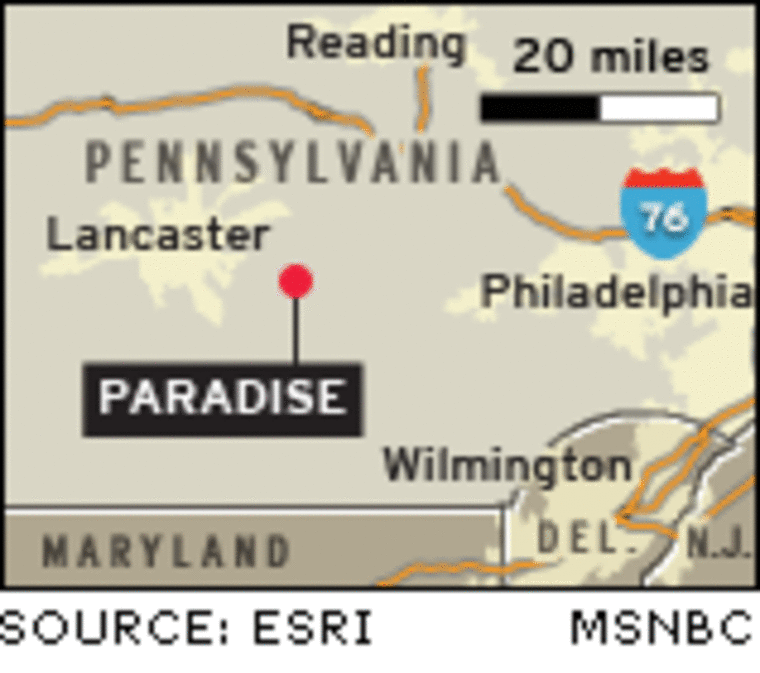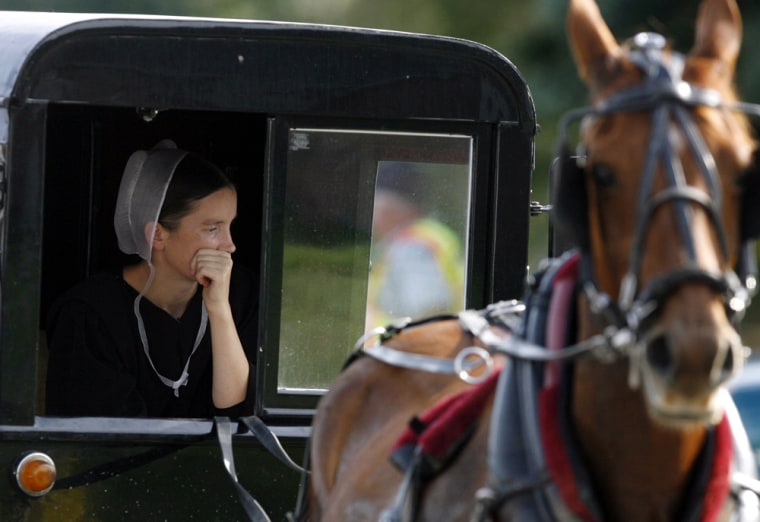NICKEL MINES, Pa. — "We don't know what God's purpose is," John told me, "but we believe there is a purpose." We were standing on the edge of a pumpkin patch.
John is an Amish man who had stepped away from a picking crew of four other men. They gently tossed each pumpkin to another worker riding on the back of a wagon pulled by a horse. No tractor. No engine.
John said he wouldn't do a television interview. The Amish believe pictures are a sign of vanity, and pictures on TV are an even worse way of indulging in the evils of the world.
But John was willing to talk about the horrible school shooting that brought so much evil to this peaceful world. "We're very concerned that no message of revenge gets out," he said. "We believe in forgiveness.”
‘Life has to go on’
My assignment was to find out how the Amish community is dealing with this unspeakable tragedy. John was one of the few members of the community who spoke openly, but only on the condition of anonymity because he did not feel comfortable being identified.
The pumpkin patch was at the bottom of a hillside where a one-room schoolhouse sat. It was just like the schoolhouse that Charles Carl Roberts besieged.
Kids were playing in the yard outside of the school, as John chatted with us. I was surprised. He wasn't. "Life has to go on, we have to pick up the pieces and go on," he said almost matter-of-factly.
Don't misunderstand John or the other members of his community. Don't let the 18th century clothes he wore, plain black slacks held up by suspenders, plain white shirt, his straight beard, and otherwise clean shaven face and straw hat, don't let that make you think for one second that he doesn't hurt, grieve or mourn.

His faith teaches him to believe all of this horror will help bring him and his neighbors closer to their God, closer to each other and closer to "the English."
The English are the rest of the surrounding community because that's the language they speak. The Amish speak a dialect of German in their homes and to each other. Not with the outside world.
Part of the community
John explained that the Amish aren't as isolated as many people apparently think. In fact, Professor Donald Kraybill, a cultural sociologist and local expert, says 60 percent of the Amish run small businesses; only 40 percent these days are traditional farmers.
They work in businesses that include woodworking, furniture making and metal manufacturing. Trade-based businesses, rather than service- or sales-based businesses, that generate in some cases $4 million to $5 million a year in revenue.
Myron Stoltzfus runs a butcher shop and deli in the village of Intercourse. He and John are neighbors and friends. Stoltzfus explained how the Amish aren't really a separate community, but rather a part of the entire community here.
I asked if he thought the shooting would change the way of life around here? "No, not at all," Stoltzfus answered without hesitation. "They believe what happened was God ordained," he said. "They don't want to be trapped by bitterness."
Technology that doesn’t impose
While the most familiar image of the Amish is a horse and buggy cracking down a long country road, Kraybill explained that many Amish people do use modern forms of technology, but "they make a big distinction between owning technology and using it."
For example, they will use electricity from a battery to power safety lights on buggies for night driving, but they won't hook up to the local power lines to use modern appliances in their home. Many will take a taxi but they won't drive a car.
Kraybill said the line is "whether the technology in some way poses a threat to their community." That's why TV, the Internet and other technologies have no place in an Amish household. And the size of their communities is growing every year.
‘God’s blessing to everyone’
Back in the pumpkin patch, the midday sun was getting hot. John had work to do. Pumpkins are a cash crop, unlike most of the corn and alfalfa in many of the fields.
John said the community is especially concerned that many of the children who were killed or wounded have young parents in their mid-20's to mid-30's. Brothers who escaped had to leave sisters behind with the gunman.
I had heard that some people from the Amish community were perhaps going to meet with Marie Roberts, the gunman's wife. John assured me that would happen soon, if it hadn't already.
"They need support, they need help," he said. "We will send them flowers." He expressed concern about how difficult it would be for the three Roberts children when they return to school.
Finally he asked me to promise to include this message in my story. "We appreciate the help and support of the police and firefighters and our neighbors. God's blessing to everyone. God has a reason for this. We don't know yet and we may not find out in our lives."
And that was OK with John. A reserved, plain-dressing, dignified Amish man, who then turned and walked to finish his work picking pumpkins with his neighbors.
